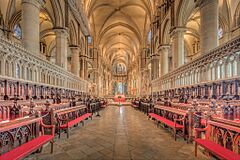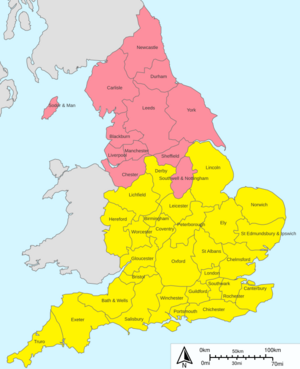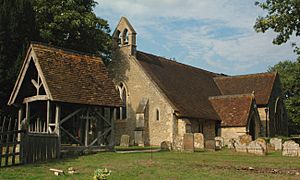Church of England facts for kids
Quick facts for kids Church of England |
|
|---|---|
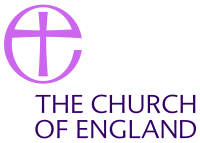 |
|
| Classification | Protestant |
| Orientation | Anglican |
| Scripture | Protestant Bible |
| Theology | Anglican doctrine |
| Polity | Episcopal |
| Supreme Governor | Charles III |
| Primate | Stephen Cottrell (acting) |
| Associations | Anglican Communion Porvoo Communion World Council of Churches |
| Region | England, Wales (cross-border parishes) Isle of Man Channel Islands Continental Europe |
| Headquarters | Church House, Westminster, England |
| Founder |
|
| Separated from | Roman Catholic Church (1534) |
| Separations | Separatists (1534 onwards) Puritans (Congregationalists, Baptists and English Presbyterians) (17th century) Methodists (18th century) Plymouth Brethren (1820s) Free Church of England (1844) Church of Ireland (1871) Church in Wales (1920) Ordinariate of Our Lady of Walsingham (2011) |
| Members | 23 million (baptised; 2020) |
| Other name(s) | Anglican Church |
The Church of England (often called the C of E) is the official Christian church in England. It is also found in the Crown Dependencies, like the Isle of Man. This church was the first part of the worldwide Anglican tradition. Its history goes back to early Christian groups in Roman Britain around the 3rd century. It also connects to a mission in the 6th century led by Augustine of Canterbury to the Kingdom of Kent. People who belong to the Church of England are called Anglicans.
In 1534, King Henry VIII decided the Church of England would no longer follow the Pope's authority. This started the English Reformation. A key person who shaped the Church of England's beliefs was Thomas Cranmer. He created the church's main prayer book, the Book of Common Prayer. The Pope's authority was briefly brought back by Mary I. But her sister, Elizabeth I, ended it again. The Elizabethan Settlement (from 1559–1563) finished the English Reformation. It set the Church of England on a path to be a "middle way" between different types of Protestantism. It also became a church that is both Reformed (like many Protestant churches) and Catholic (keeping some older traditions).
During the Reformation, people from both Catholic and Protestant sides faced difficulties. Laws were made to punish Catholics and other Protestants who did not follow the Church of England. Different groups kept challenging the church's leaders and beliefs. This led to the English Civil War in the 17th century. After the war, a group called the Puritans took control. They got rid of the Book of Common Prayer and bishops. But these were brought back in 1660 when the monarchy returned.
Since the English Reformation, the Church of England has used the English language in its services. It is a "broad church," meaning it has different ways of thinking. The main traditions are Anglo-Catholic, high church, central church, and low church. The low church has a growing evangelical group. The British monarch (currently Charles III) is the supreme governor. The archbishop of Canterbury (currently Stephen Cottrell as acting Primate) is the most senior leader. The church is organized into dioceses, each led by a bishop. Inside each diocese are local parishes. The General Synod of the Church of England is the church's law-making body. Its decisions must be approved by the Parliament of the United Kingdom.
Contents
History of the Church of England
Early Beginnings
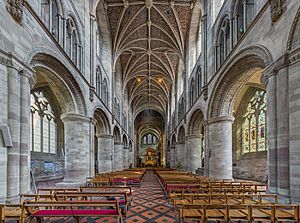
There is proof of Christianity in Roman Britain as early as the 3rd century. After the Roman Empire fell, England was taken over by the Anglo-Saxons. They followed pagan beliefs. The Celtic church was then only found in Cornwall and Wales. In 597, Pope Gregory I sent missionaries to England to teach Christianity to the Anglo-Saxons. This mission was led by Augustine. He became the first archbishop of Canterbury. The Church of England sees 597 as the start of its official history.
In Northumbria, Celtic missionaries and Roman missionaries had different ideas. They disagreed on the date of Easter, baptism customs, and how monks should cut their hair. King Oswiu of Northumbria called a meeting called the Synod of Whitby in 664. The king decided Northumbria would follow the Roman way. He believed this was because Saint Peter and the bishops of Rome held the "keys of the kingdom of heaven."
By the late Middle Ages, Catholicism was a very important part of English life. About 9,000 local churches (parishes) covered all of England. They were overseen by bishops and, finally, the Pope in Rome. Catholic teaching said that people could work with God to achieve salvation by doing good deeds. God's grace was given through the seven sacraments. In the Mass, a priest would bless bread and wine. Catholics believed these became the body and blood of Christ. The church taught that the Mass was an offering to God. It was also a prayer to help souls in purgatory.
The English Reformation
In 1527, Henry VIII wanted a son to be his heir. He asked Pope Clement VII to cancel his marriage to Catherine of Aragon. When the Pope said no, Henry used Parliament to take control over the English church. In 1533, Parliament passed a law that stopped legal cases from being appealed outside England. This allowed the Archbishop of Canterbury to cancel the marriage without the Pope's approval. In November 1534, the Act of Supremacy officially ended the Pope's power. It declared Henry the Supreme Head of the Church of England.
Henry's own religious beliefs stayed mostly Catholic. But he allied with Protestants to secure his power over the church. A main idea of the Protestant Reformation was "justification by faith alone." This meant people were saved by faith, not by good deeds. This idea changed how people viewed many Catholic practices.
Between 1536 and 1540, Henry closed down many monasteries. These religious houses owned a lot of rich land. He took their money, sold their properties, and gave pensions to the people who lived there. The money from these sales helped pay for wars. Historian George W. Bernard said that closing the monasteries was a huge event in English history. There were nearly 900 religious houses, with about 12,000 people living in them.
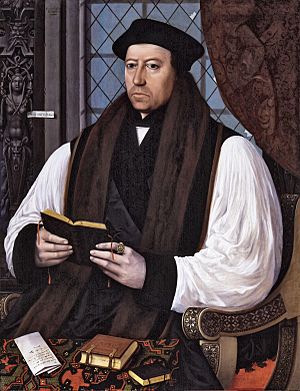
When Edward VI was king (1547–1553), the Church of England changed its beliefs a lot. "Justification by faith" became a main teaching. The government allowed the destruction of religious images and relics. Stained glass, statues, and other church decorations were damaged or removed. Church walls were painted white and covered with Bible verses. The biggest change was using English in church services instead of Latin. Archbishop Thomas Cranmer wrote the 1549 Book of Common Prayer. This book taught "justification by faith" and rejected Catholic ideas like the bread and wine becoming the actual body and blood of Christ. A revised 1552 Book of Common Prayer followed. Along with the Book of Common Prayer, The Thirty-nine Articles and The Books of Homilies became the basis of Anglican beliefs.
During the time of Mary I (1553–1558), England briefly rejoined the Catholic Church. Mary died without children. So, her half-sister Queen Elizabeth I had to decide the church's future. The Elizabethan Religious Settlement brought the church back to how it was before Edward's death. The Act of Supremacy made the monarch the Church's Supreme Governor of the Church of England. The Act of Uniformity brought back a slightly changed 1552 Book of Common Prayer. In 1571, the Thirty-nine Articles were approved by Parliament as the church's official beliefs. This settlement made the Church of England Protestant. It was seen as a "middle way" between different Protestant groups.
The Church of England became the established church (meaning it was officially linked to the state). The Act of Settlement 1701 says that the monarch must be Protestant and a member of the Church of England. The Coronation Oath Act 1688 requires the new monarch to promise to uphold the Protestant religion in the United Kingdom.
Changes in the Stuart Period
Arguments over control of the church continued during the reigns of James I and Charles I. This led to the First English Civil War in 1642. Two main groups were involved: Puritans, who wanted to make the church more Protestant, and those who wanted to keep older traditions. Religious disagreements often had political parts. For example, bishops had religious roles, but also acted as government censors. They could ban sermons and writings. They also sat in Parliament and sometimes blocked laws the king did not like.
After the Royalists lost the war in 1646, bishops were officially removed. In 1649, the Commonwealth of England outlawed many church practices. Presbyterian church structures replaced the bishops. Worship using the Book of Common Prayer was banned. But about a quarter of English clergy refused to follow these new rules. Other Puritan groups also disagreed with state-controlled religion. These included Congregationalists and Baptists.
After the monarchy was restored in 1660, Parliament brought the Church of England back to a form similar to Elizabeth I's time. Many Protestants who did not follow the Church of England (called Nonconformists) tried to rejoin. But William III of England ended these talks. The idea of having all English people in one church was given up. The religious landscape of England became what it is today. The Anglican church was in the middle, and Nonconformists existed outside it. About 2,000 church ministers were removed because they had not been ordained by bishops. Roman Catholics, who were a small part of the population, were tolerated but had few official rights.
Church Growth Overseas

As the English Empire grew, English (and later British) settlers and leaders took the Church of England's beliefs and practices with them. They formed new branches of the Church of England overseas.
The Diocese of Nova Scotia was created in 1787. It was the first Church of England area outside England and Wales. It covered a large part of what is now Canada. As these areas became independent, many of their churches became separate organizations. But they stayed connected to the Church of England through the Anglican Communion. For example, the "Church of England in Canada" became the Anglican Church of Canada in 1955.
In Bermuda, the first Church of England services were held by Reverend Richard Buck in 1609. This was after his ship, the Sea Venture, was wrecked there. Bermuda's churches were part of other dioceses until 1919. Then, Bermuda got its own bishop. The Church of England in Bermuda was renamed the Anglican Church of Bermuda in 1978. It is directly linked to the Archbishop of Canterbury. St Peter's Church in St George's Town is the oldest Anglican church outside the British Isles.
The Church of India, Burma and Ceylon was set up in Colonial India in 1813. Anglican missionaries arrived in Nigeria in 1842. By the late 20th century, the Church of Nigeria was one of the fastest-growing Anglican churches. The church also started in Hong Kong and Macau in 1843. In 1998, the Hong Kong Sheng Kung Hui became a province of the Anglican Communion. The Church also began in Sri Lanka in 1796. The Church of Ceylon was established there in 1845.
Recent Times
Changes in Church Attendance

Bishop Sarah Mullally has said that fewer people attending services is not always bad. She believes people can still connect with God outside of church buildings. For example, through social media or community projects. The Church of England estimates that 35 to 50 million people visit its churches as tourists each year. Also, 9.7 million people visit at least one church annually. About 1 million students are educated in the 4,700 Church of England schools. In 2019, about 10 million people visited a cathedral.
However, the archbishops of Canterbury and York warned in 2015 that the Church of England needed to change. Sunday attendance had dropped by half to 800,000 in 40 years. They noted that church members and clergy were getting older. Between 1969 and 2010, almost 1,800 church buildings were closed. This was about 11% of all churches. By 2019, about 20 to 25 churches closed each year. In 2018, the church announced a £27 million plan to create 100 new churches.
Impact of the COVID-19 Pandemic
The COVID-19 pandemic greatly affected church attendance. Numbers in 2020 and 2021 were much lower than in 2019. By 2022, attendance was still down compared to before the pandemic. In 2022, the average weekly attendance had dropped from 34 to 25 people per church. Easter and Christmas services also saw fewer people. In 2023, average weekly attendance was 8% lower than expected before the pandemic. However, attendance at baptisms and marriages increased by over 20%.
Beliefs and Practices
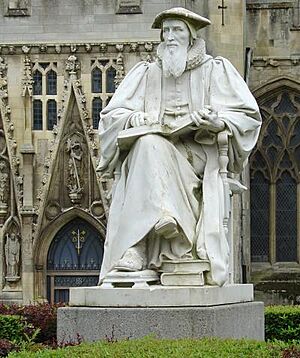

Thomas Cranmer was a key figure in shaping Anglican beliefs after the English Reformation. He helped create the Thirty-Nine Articles of Religion, the Book of Common Prayer, and the Books of Homilies. The Church of England's rules (canon law) say that the Christian scriptures are the source of its beliefs. Its beliefs also come from the teachings of early Church leaders and important church meetings (councils), as long as they agree with the Bible. These beliefs are found in the Thirty-Nine Articles, the Book of Common Prayer, and the Ordinal (which describes how deacons, priests, and bishops are ordained).
The Church of England's beliefs today largely come from the Elizabethan Settlement. Anglicanism developed as a "middle way" between different types of Protestantism. The Church of England believes that the Bible contains everything needed for salvation. It is the final guide in matters of belief. The Thirty-nine Articles are the church's only official statement of faith. The Church of England kept three levels of ministry (bishops, priests, and deacons). It also kept the idea of apostolic succession for bishops. This means its bishops can trace their authority back to the apostles. Because of this, it is described as both Reformed and Catholic.
The Church of England allows for a wide range of opinions among its clergy and members. This means Anglicans who focus on the Catholic tradition and those who focus on the Reformed tradition can exist together. The three main ways of thinking in the Church of England are called high church (or Anglo-Catholic), low church (or evangelical Anglican), and broad church (or liberal). The high church group emphasizes the Church of England's connection to the Catholic Church before the Reformation. They value old church practices and the special role of priests. Anglo-Catholics keep many traditional Catholic practices. The low church group is more Protestant in its services and beliefs. They stress the importance of the Bible, preaching, salvation by faith, and personal conversion. The liberal broad church group emphasizes using reason in understanding faith. They believe Christian beliefs should adapt to new knowledge. They also stress social and political action. In 2013, 40% of Church of England worshippers attended evangelical Anglican churches. These churches often attract more men and young adults.
Worship and Services
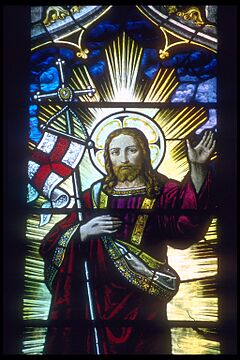
In 1604, King James I ordered an English translation of the Bible. This became the King James Version, published in 1611. It was allowed for use in churches. The Church of England's official book for services is the 1662 version of the Book of Common Prayer. In 2000, the General Synod approved a modern book called Common Worship. This can be used instead of the older book. It offers different services, mostly in modern language.
Church services follow the traditional liturgical year and the calendar of saints. The sacraments of baptism and the eucharist are generally seen as necessary for salvation. Infant baptism is practiced. Later, people baptized as babies can receive confirmation from a bishop. At this time, they confirm the promises made by their parents at baptism. The eucharist is believed to be a "memorial of Christ's once-for-all redemptive acts." It is believed that Christ is truly present and received by faith.
The use of hymns and music in the Church of England has changed a lot over time. Traditional Choral evensong is common in most cathedrals. The style of psalm chanting goes back to the church's early roots. In the 18th century, leaders like Charles Wesley introduced new styles of worship with poetic hymns. In the late 20th century, the Charismatic Movement changed worship in many churches. These churches now use a more modern style of service with less ritual. They often include contemporary worship music.
The Church of England has many members and clergy with liberal views. Some clergy have doubts about the physical resurrection of Jesus. Others, like Giles Fraser, have suggested that the virgin birth of Jesus could be understood as a story with a deeper meaning. A 2014 survey found that some clergy were unsure about God. Many churches aim to be welcoming to new people. For example, one report suggested opening a "pagan church" where Christianity is central to reach spiritual people.
The Church of England is looking into how God is referred to in church services. This project, started in 2023, is about "gendered language."
Women in Ministry
Women were appointed as deaconesses starting in 1861. But they could not fully act as deacons or be considered ordained clergy. Women have always been able to serve as lay readers. During the First World War, some women were called "bishop's messengers." They led missions and ran churches when men were away. After the war, women were not appointed as lay readers again until 1969.
Laws allowing women to be ordained as deacons were passed in 1986. The first women deacons were ordained in 1987. The ordination of women as priests was approved in 1992. It began in 1994. In 2010, for the first time, more women than men were ordained as priests.
In July 2005, the church's General Synod voted to start the process of allowing women to become bishops. In February 2006, the synod voted to explore ways for churches that did not want a woman bishop to have other leadership. On July 7, 2008, the synod approved the ordination of women as bishops. However, further laws were needed. These were narrowly rejected in November 2012. On November 20, 2013, the General Synod voted strongly in favor of a plan to allow women bishops.
On July 14, 2014, the General Synod finally approved women as bishops. In December 2014, Libby Lane was announced as the first woman to become a bishop in the Church of England. She was consecrated as a bishop in January 2015. In July 2015, Rachel Treweek became the first woman to be a diocesan bishop. She became the Bishop of Gloucester. She and Sarah Mullally, Bishop of Crediton, were the first women bishops ordained at Canterbury Cathedral. Treweek later spoke about using gender-neutral language for God, saying "God is not to be seen as male. God is God."
In May 2018, the Diocese of London consecrated Dame Sarah Mullally as the first woman to serve as the Bishop of London. Bishop Sarah Mullally holds the third most senior position in the Church of England. She has described herself as a feminist. She ordains both men and women to the priesthood.
Social Work
Helping Communities
The Church of England set up the Church Urban Fund in the 1980s. Its goal is to fight poverty and hardship. It sees poverty as a trap for people and communities. It can lead to homelessness, hunger, isolation, and mental health problems. The Church believes poverty reduces confidence and life expectancy. People born into poor conditions often struggle to escape them.
Child Poverty
In some parts of Liverpool, Manchester, and Newcastle, two-thirds of babies are born into poverty. They have fewer opportunities in life. Their life expectancy can be 15 years lower than babies born in wealthier areas. Paul Hackwood, from the Church Urban Fund, said: "The deep-rooted unfairness in our society is highlighted by these stark statistics. Children being born in this country, just a few miles apart, couldn't witness a more wildly differing start to life." He added that the UK has high child poverty compared to other Western countries.
Fighting Hunger
Many important people in the Church of England have spoken out against poverty and cuts to welfare in the UK. In 2014, 27 bishops and other Christian leaders signed a letter. They asked David Cameron to make sure people had enough to eat. They pointed out that many older people had to choose between heating their homes or eating. They also noted that families' wages had stayed the same while food prices went up. They said that over half of people using food banks were in that situation because of problems with the benefit system.
Thousands of UK citizens use food banks. The church's campaign to end hunger called this "truly shocking." They asked for a national day of fasting on April 4, 2014.
Membership and Attendance
In 2009, the Church of England estimated it had about 25–26 million baptised members. This was about 47% of the English population. This number stayed similar until 2020. In 2020, the church reported about 23 million baptized members, which was about 41% of the English population.
In 2018, a survey found that 14% of Britons, about 10 million people, said they were members of the Church of England. This was called a "decline." In 2023, about 53% of Christians in the UK, or 16.7 million people, identified as Anglican. This includes most in the Church of England.
Because the Church of England is the official church, generally anyone can be married, have their children baptized, or have a funeral in their local church. This is true even if they are not baptized or regular churchgoers. In 2017, about 20% of children were baptized in the Church of England. The church's data shows that about 8 million people attended services during the Christmas season. This includes special services and carol concerts.
Between 1890 and 2001, churchgoing in the UK steadily declined. From 1968 to 1999, Anglican Sunday church attendance almost halved. By 2014, Sunday attendance was down to 1.4% of the population. The Church of England publishes yearly statistics. In 2022, average weekly attendance was 654,000. In 2023, it increased to 693,000. Easter attendance was 938,000 in 2023, and Christmas attendance was 1,961,000.
Church Leadership and Structure
In 2020, there were almost 20,000 active clergy (church leaders) in the Church of England. This included 7,200 retired clergy who still served. In that year, 580 people became ordained. About 33% of ordained clergy were women, up from 26% in 2016.
The Church of England's rules say that the King is the highest power under God in England. He has authority over all people and matters, both church and government. In reality, this power is often used through Parliament and with advice from the Prime Minister.
The Church of Ireland and the Church in Wales became separate from the Church of England in 1869 and 1920. They are now independent churches in the Anglican Communion. Scotland's national church is Presbyterian. But the Scottish Episcopal Church is part of the Anglican Communion.
Besides England, the Church of England also has power in the Isle of Man, the Channel Islands, and some churches in Wales. Churches in Europe are part of the Diocese of Gibraltar in Europe.
The church is organized from local to national levels:
- Parish: This is the most local level. It often has one church building and community. Many parishes are now working together for money reasons. A local priest looks after the parish. This priest might be called a vicar or rector. The priest and an elected group from the church members (the parochial church council) run the parish together.
- Deanery: This is an area with several parishes. A Rural Dean is in charge of this area. Each parish elects members to the deanery synod. These members vote for representatives to the diocesan synod.
- Archdeaconry: This area is under the authority of an archdeacon. It includes several deaneries.
- Diocese: This is an area under the authority of a bishop. For example, the Diocese of Durham. Each diocese has a cathedral. There might be other bishops (called suffragan bishops) who help the main bishop. In very large dioceses, there might be "episcopal areas" with their own "area bishops." The bishops work with an elected group of church members and clergy (the Diocesan Synod) to run the diocese. A diocese is divided into archdeaconries.
- Province: There are two provinces: Canterbury and York. Each is under the authority of an archbishop. Decisions for the province are made by the General Synod. A province is divided into dioceses.
- Primacy: The Archbishop of York is called the "Primate of England." This is mostly an honorary title. The Archbishop of Canterbury is the "Primate of All England." He has power over all of England and Wales. He is also a central figure for the worldwide Anglican Communion.
- Royal Peculiar: A few churches, like Westminster Abbey, are directly linked to the King or Queen. They follow church rules but are outside the bishop's authority.
Priests are appointed by patrons. These can be individuals, groups, or the King. No priest can start work in a parish without swearing loyalty to the King and promising to obey the bishop. Assistant clergy (curates) are appointed by rectors or vicars. Cathedral clergy are appointed by the King, the bishop, or the cathedral leaders themselves.
Senior Leaders
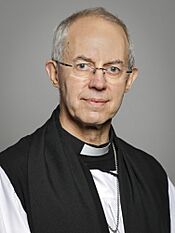
The most senior bishop in the Church of England is the Archbishop of Canterbury. He is the leader of the southern province of England, called the Province of Canterbury. He is also the main leader for the worldwide Anglican Communion. Justin Welby was the Archbishop of Canterbury until his resignation became effective on January 6, 2025.
The second most senior bishop is the Archbishop of York. He is the leader of the northern province of England, called the Province of York. He is known as the Primate of England. Stephen Cottrell became Archbishop of York in 2020. The Bishop of London, the Bishop of Durham, and the Bishop of Winchester are the next most senior bishops. They automatically become members of the House of Lords.
Appointing Bishops
The process of appointing bishops is complicated. It balances old traditions with modern ideas. The Crown Nominations Committee suggests names to the Prime Minister. The Prime Minister then advises the King.
Governing Bodies
The Church of England has a law-making body called the General Synod. It can create two types of laws: measures and canons. Measures must be approved by the British Parliament. Once approved, they become part of English law. Canons are the laws of the church itself. They need Royal approval.
There are also older assemblies called the Convocation of the English Clergy. Most of their jobs were moved to the General Synod in 1969. Additionally, there are Diocesan Synods and deanery synods. These are the governing bodies for the smaller parts of the Church.
Church Leaders in Parliament
Out of the 42 bishops in the Church of England, 26 are allowed to sit in the House of Lords. The Archbishops of Canterbury and York automatically have seats. So do the bishops of London, Durham, and Winchester. The other 21 seats are filled by bishops based on how long they have been consecrated. It can take several years for a bishop to join the House of Lords. Once there, they are called a Lord Spiritual. The Bishop of Sodor and Man and the Bishop of Gibraltar in Europe cannot sit in the House of Lords. This is because their areas are outside the United Kingdom.
Crown Dependencies
The Church of England is also the official church in the Crown Dependencies. These are the Isle of Man, the Bailiwick of Jersey, and the Bailiwick of Guernsey. The Isle of Man has its own diocese, Sodor and Man. The Bishop of Sodor and Man is a member of the legislative council on the island. The Channel Islands are usually under the Bishop of Winchester. But this power has been temporarily given to the Bishop of Dover since 2015. In Jersey, the Dean of Jersey is a non-voting member of the States of Jersey. In Guernsey, the Church of England is the official church.
Money and Funding
The Church of England is an official church, but it does not get direct money from the government. It does receive some funding for building work. Donations are its biggest source of income. It also relies on money from its old investments. In 2005, the Church of England spent about £900 million.
The Church of England manages investments worth over £8 billion.
Online Church Information
The Church of England has an online directory called A Church Near You. It lists over 16,000 churches. It has 20,000 editors in 42 dioceses. This directory helps churches share their location, contact details, and event information. It also helps people find their local church. The site offers free resources like hymns and videos.
The Church Heritage Record has information on over 16,000 church buildings. This includes their history, art, and surrounding nature. You can search by church name, diocese, building date, and other details. Some types of churches listed include:
- Major Parish Church: These are important and well-loved churches in England. They are usually large and historically significant. As of December 2021, there were 312 such churches.
- Festival Church: These churches are not used for weekly services. They are used for special events and occasional services. As of December 2021, there were 19 such churches.
- CCT Church: These churches are cared for by the Churches Conservation Trust. As of December 2021, there were 345 such churches.
- Friendless Church: As of December 2021, there were 24 such churches. The Friends of Friendless Churches cares for 60 churches in England and Wales.
Images for kids
See also
 In Spanish: Iglesia de Inglaterra para niños
In Spanish: Iglesia de Inglaterra para niños


